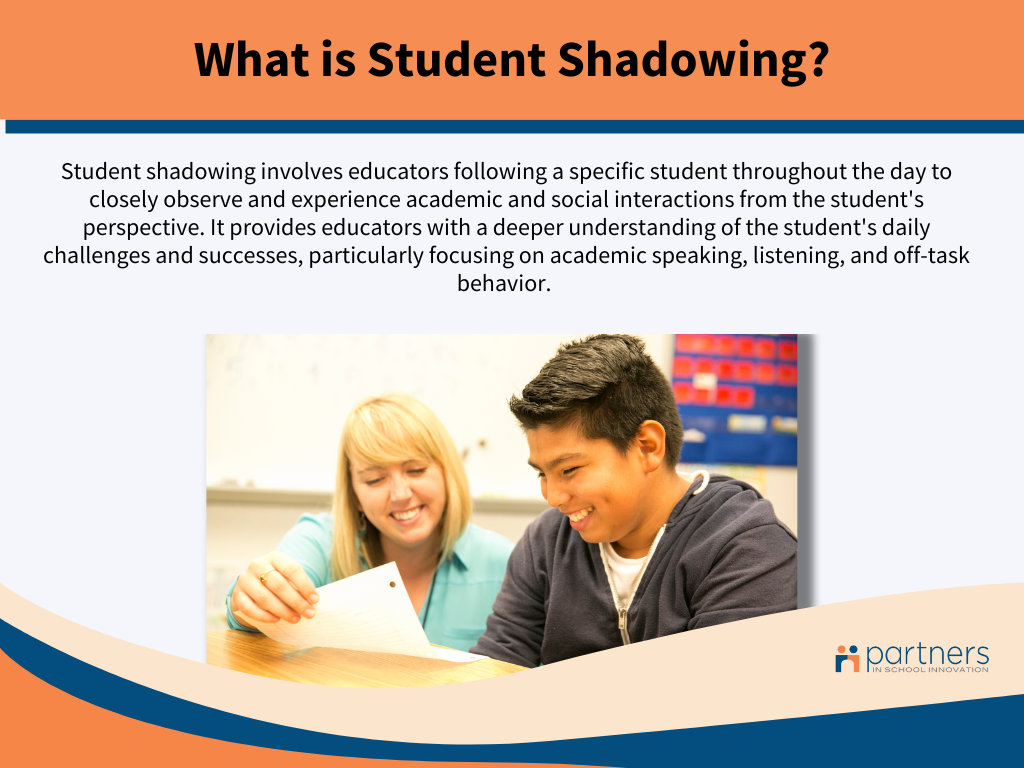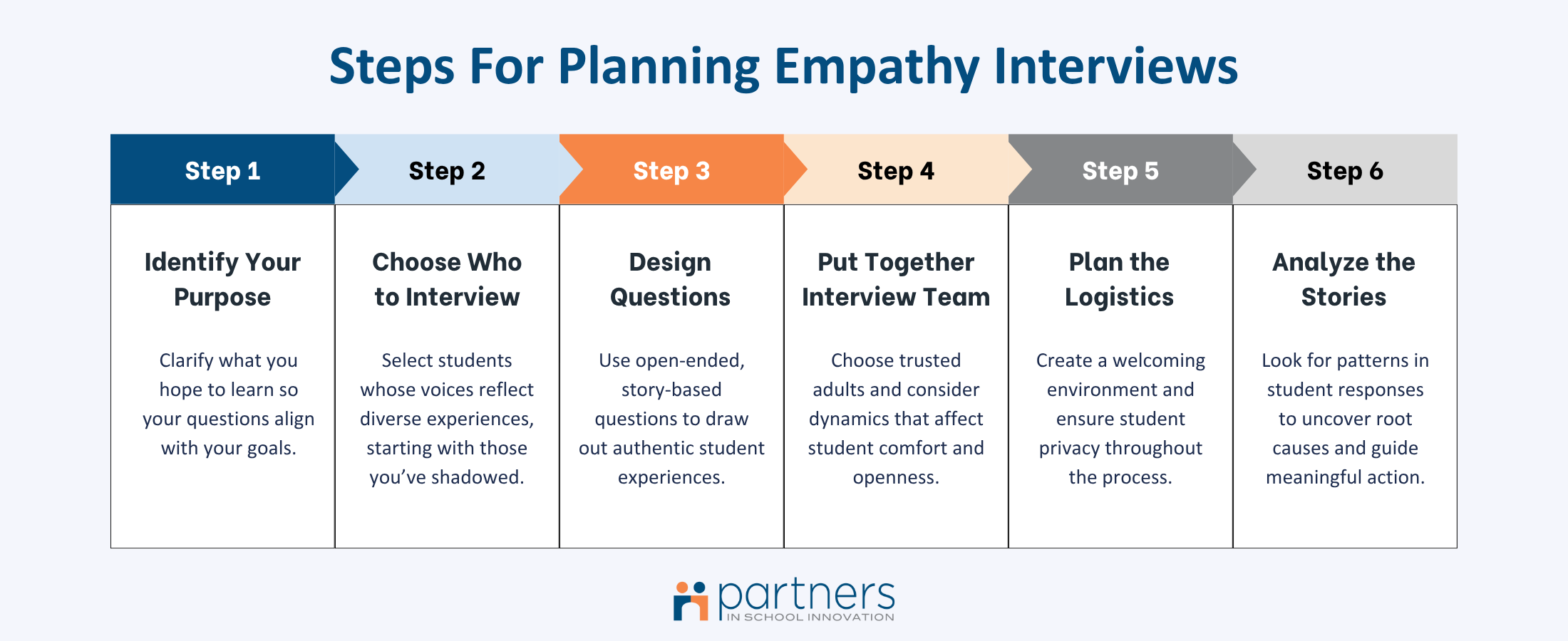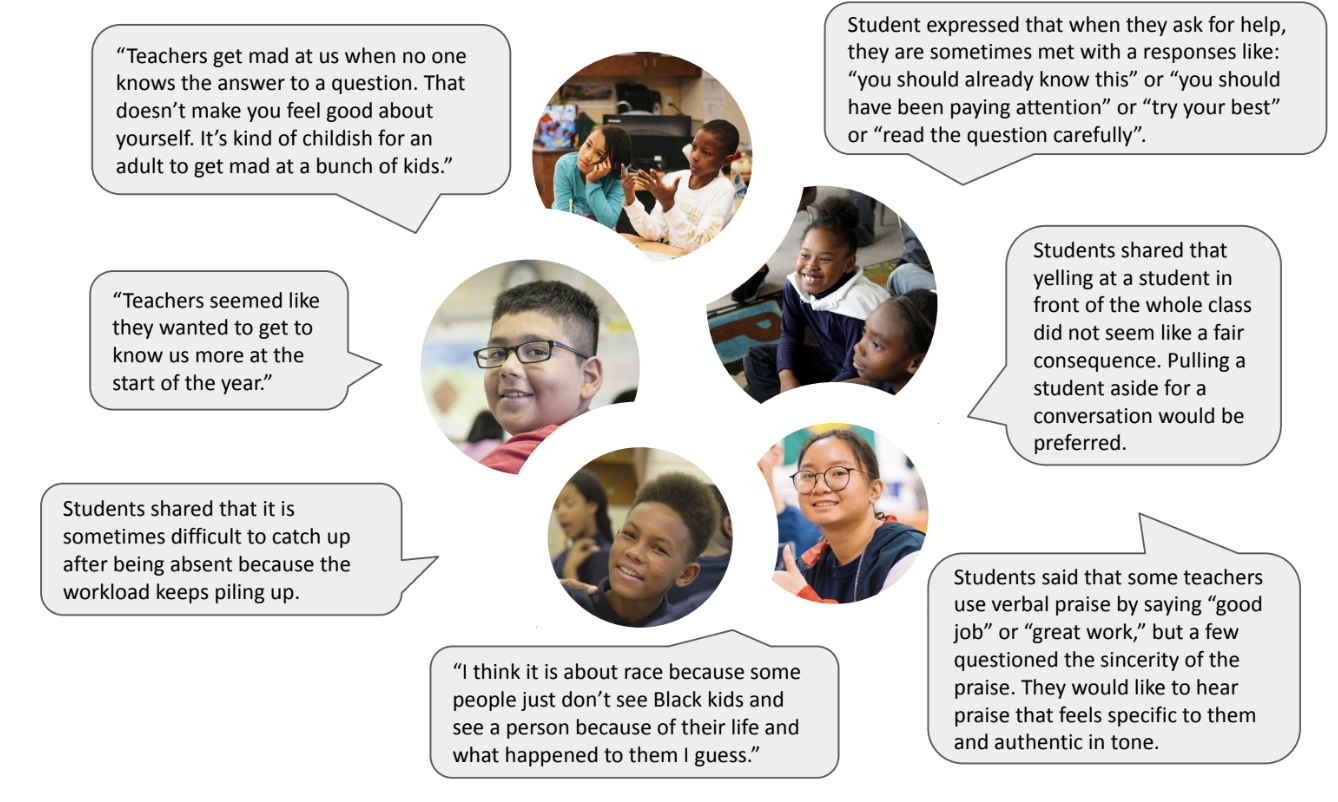Seeing and Hearing Multilingual Learners: Shadowing, Empathy Interviews, and Amplifying Student Voices
Working alongside educators and school leaders, our coaches at Partners in School innovation have learned that supporting Multilingual Learners (MLLs) effectively starts with understanding their experiences. These students bring incredible strengths and perspectives, but they also face unique challenges that aren’t always visible in lesson plans or traditional instructional data collection.
This article is part of a series on supporting MLLs, and it focuses on two foundational practices: MLL Shadowing and Empathy Interviews.
If you’re new to this series, here’s what we’ve covered so far and what’s coming next:
Understanding and Supporting Multilingual Learners: A Guide to Differentiating Instruction
(You're here!) - Seeing and Hearing Multilingual Learners: Shadowing, Empathy Interviews, and Amplifying Student Voices
How to Create Language Objectives: Strategies for Differentiating Instruction for MLLs
Structured Language Practice: Strategies for Differentiating Instruction for MLLs
The first article focused on the challenges MLLs face in the classroom and outlines where you can begin as an educator to ensure all students have access to meaningful learning opportunities.
In this piece, we dive into more detail about how to implement MLL Shadowing and Empathy Interviews. These are practical tools to start the process of understanding students’ lived experiences, and their experience in the classroom, so that you can start taking targeted steps toward change.
Why Understanding and Building Empathy Comes First
Before designing instruction or implementing differentiation strategies, we have to understand the students we’re working to support. Shadowing and empathy interviews offer a way to see the classroom through the eyes of Multilingual and English Learners, helping ensure that what we plan next is more likely to positively impact their experience.
What is Multilingual Learner (MLL) Shadowing?
Multilingual Learner (MLL) Shadowing is a way to step into a student's shoes for a day. By observing their interactions in class and during group work, you can start to see when they're thriving or where they might need more support. As an observer, you might sit in on lessons, watch group work, and notice when the student seems engaged—or when they’re struggling (Soto, Shadowing Multilingual Learners).
Image description: An infographic outlining the definition of student shadowing accompanied by an image of a teacher discussing schoolwork with a student.
The goal of shadowing isn’t to evaluate the student, but to understand their experience. As you observe, you’ll start to notice patterns that give you deeper insight into their reality:
When are they speaking or listening actively?
Are they working with peers, or working quietly on their own?
How often do they receive feedback or encouragement from teachers?
Another interesting thing about shadowing is that it often highlights gaps between what’s planned and what’s happening in real time. For example, a classroom activity may be designed for collaboration, but without the right tools or scaffolds, an MLL student might not feel equipped to join in.
Related Content: How a San Jose School Transformed Their Support for Multilingual Learners
To make your observations more focused and actionable, use our MLL Shadowing Checklist. Partners in School Innovation coaches worked with Ivannia Soto, author of Shadowing Multilingual Learners, to develop this checklist to help educators focus their observations on key areas like academic speaking, listening, and behavior. It’ll help with making sure your shadowing experience translates into meaningful insights and practical next steps.
What are Empathy Interviews?
Empathy Interviews take shadowing a step further and are a process our Partners coaches developed to follow shadowing. After observing students, we advise that you make time to sit down with them for a one-on-one conversation to hear their thoughts, feelings, and experiences directly.
These interviews are designed to uncover the “why” behind what you observed during shadowing. For example, let’s say you noticed that a student appeared disengaged during group work. During an empathy interview, they might share that they didn’t fully understand the instructions or felt nervous about speaking in English in front of their peers. These insights reveal barriers that traditional data or observation alone might not uncover.
How to Plan Empathy Interviews
When our coaches lead this process themselves, or coach educators through it in professional development sessions, we’ve found that Empathy interviews work best when they’re carefully planned with thoughtful questions, clear goals, and a safe space for students to share openly.
To help guide you through the planning process, we’ve created an Empathy Interview Guide that outlines some helpful guidelines and provides sample questions for educators to use.
Image description: An infographic outlining the six steps for planning empathy interviews. The steps outlined include 1) Identify your purpose, 2) Choose who to interview, 3) Design questions, 4) Put together the interview team, 5) Plan the logistics, and 6) Analyze the stories.
We also draw on insights from Kari Nelsestuen and Julie Smith’s article on empathy interviews, published by Learning Forward. Below is a step-by-step approach informed by their recommendations and our work at Partners in School Innovation.
Step 1: Identify Your Purpose
Start by asking yourself: Why are you conducting these interviews? What do you hope to learn? Whether it’s uncovering the root causes of disengagement, identifying barriers, or co-designing solutions with students, having a clear purpose ensures the questions you ask align with your goals.
For example, if your focus is on improving group work for MLLs, your purpose might be to uncover what makes group activities engaging—or alienating—for these students. This clarity will guide your entire process.
Step 2: Choose Who You Will Interview
After shadowing, think about which students’ voices you need to hear. Start with the students you observed. They've already provided valuable insights into their daily experiences, and an interview can help you dive deeper.
For MLL-focused interviews, include students with diverse language backgrounds and experiences. Consider newer students, long-term English learners, or those with varying confidence levels in using academic language. This diversity ensures you capture a range of perspectives and patterns that can inform meaningful changes in your teaching practices.
Step 3: Design Thoughtful Questions
Open-ended, story-based questions work best because they encourage students to share experiences in depth. Here are some examples to get you started:
“Tell me about a time when you felt really proud of something you did in class.”
“What was the last group project like for you?”
“What makes you feel included—or left out—at school?”
“Can you share a story about a time when you struggled to understand something in class? What helped, or what didn’t?”
Follow up with prompts like, “Can you tell me more about that?” or “What made you feel that way?” These prompts invite students to expand on their answers, giving you deeper insights.
Keep these best practices in mind as you craft your questions:
Start with questions that set a positive, welcoming tone (e.g. “Tell me about a time when you felt really proud of something you did in class.”)
Focus on getting students to share stories, not solutions.
Include prompts that allow students to describe their experiences in different settings (e.g., classroom, lunchroom, group work).
Step 4: Put Together Your Interview Team
Who conducts the interviews matters just as much as the questions you ask. Whenever possible, involve adults who already have a trusting relationship with the students—teachers, counselors, or other staff members they feel safe with.
As you assemble your team, think about potential dynamics that could affect students’ comfort:
Are there cultural, language, or power dynamics that might make students hesitant to share openly?
Do you need multilingual interviewers or translators to ensure students can express themselves fully?
Could involving family or community members as interviewers strengthen the process?
Step 5: Plan the Logistics
With your questions and team ready, it’s time to iron out the logistics. You’ll want to think about:
When and where you’ll have these interviews. Ideally this is a quiet, welcoming space where students can feel at ease. Think about times that won’t disrupt their school day or add unnecessary stress.
Data storage and confidentiality. Let students know their privacy will be respected. Securely store notes and anonymize responses so that students can feel confident sharing openly.
For example, if interviewers use a blank document or Partners’ Empathy Interview Template to take notes, these can be saved in a secure Google Drive folder without including identifying information.
Step 6: Analyze the Stories
The insights from empathy interviews come to life when you reflect on what you’ve heard and uncover patterns. One effective way to do this is through “headlining,” as recommended by Nelsestuen and Smith. Here’s how it works:
Review each interview and summarize it with descriptive sentences or direct quotes.
Group these summaries by theme to identify recurring ideas or challenges.
Focus on patterns, not just individual stories, to guide meaningful changes.
For example, if multiple students share that unclear instructions make group work stressful, this might lead you to rethink how you structure and communicate activities.
Although the context was different, this kind of intentional listening and analysis also led to meaningful change at a Philadelphia middle school we supported. When this school found that more than half of their Black students were failing at least one core academic class, educators chose to speak directly with students to understand their challenges.
Image description: A collection of speech bubbles surrounds images of middle school students smiling and engaged in classroom settings. The speech bubbles capture student feedback from students at a Philadelphia school we supported with gathering and analyzing student feedback to inform instruction, highlighting their perspectives. For example, one bubble says, “Teachers get mad at us when no one knows the answer to a question. That doesn’t make you feel good about yourself.”
By gathering student reflections and identifying common themes–like the need for more relevant instruction, stronger relationships with teachers, and clearer communication–they uncovered insights that helped reshape classroom practices. These conversations led to changes such as integrating culturally responsive materials and rethinking how teachers offered support during challenging moments.
By analyzing students’ stories with care, you’ll uncover the “why” behind their experiences so that you can take meaningful steps toward creating more equitable learning environments.
What’s Next?
Understanding is the foundation, but taking action is where transformation begins. Once you’ve built empathy and gathered meaningful insights through shadowing and empathy interviews, the next step is to use what you’ve learned to inform your teaching practices and strategies.
In the upcoming blogs in this series, we’ll dive deeper into actionable ways to support multilingual learners and English language learners, including:
Creating Language Objectives: How clear goals for language skills can help MLLs thrive in rigorous content areas
Using Explicit Vocabulary Instruction: Why teaching key terms is essential for making academic content accessible
Implementing Structured Language Practice: Ways to provide students with the tools and confidence to succeed in academic discussions
Need More Support?
If you’re ready to take these steps further, we’re here to help. Partners in School Innovation offers hands-on support for schools and districts committed to creating equitable learning environments for all students, including MLLs and English language learners. Contact our team to explore how we can support your goals and help you take meaningful steps toward equity.
You can also access more of our professional learning resources below:
Join Our Online Community of Educators
Collaborate with over 650 equity-focused education leaders sharing resources, ideas, and inspiration every week. This community connects you with peers navigating the same challenges and trusted leaders dedicated to solving systemic inequities.
Join the online community here.
Explore Online Professional Development Courses for Educators
Our on-demand, self-paced courses are designed by leading experts and focus on equity-driven strategies. These include curated activities, opportunities to practice, and space for reflection.
Popular courses include:
Leading Improvement Cycles
From Root Causes to Grassroots Action
Data for Liberation
Browse the full course catalog here.
Looking for something custom? We also create tailored courses for schools and districts. Let us know if you’d like to develop one designed to meet your unique needs.



